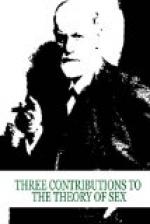Polymorphous-perverse Disposition.—It is instructive to know that under the influence of seduction the child may become polymorphous-perverse and may be misled into all sorts of transgressions. This goes to show that it carries along the adaptation for them in its disposition. The formation of such perversions meets but slight resistance because the psychic dams against sexual transgressions, such as shame, loathing and morality—which depend on the age of the child—are not yet erected or are only in the process of formation. In this respect the child perhaps does not behave differently from the average uncultured woman in whom the same polymorphous-perverse disposition exists. Such a woman may remain sexually normal under usual conditions, but under the guidance of a clever seducer she will find pleasure in every perversion and will retain the same as her sexual activity. The same polymorphous or infantile disposition fits the prostitute for her professional activity, and in the enormous number of prostitutes and of women to whom we must attribute an adaptation for prostitution, even if they do not follow this calling, it is absolutely impossible not to recognize in their uniform disposition for all perversions the universal and primitive human.
Partial Impulses.—For the rest, the influence of seduction does not aid us in unravelling the original relations of the sexual impulse, but rather confuses our understanding of the same, inasmuch as it prematurely supplies the child with the sexual object at a time when the infantile sexual impulse does not yet evince any desire for it. We must admit, however, that the infantile sexual life, though mainly under the control of erogenous zones, also shows components in which from the very beginning other persons are regarded as sexual objects. Among these we have the impulses for looking and showing off, and for cruelty, which manifest themselves somewhat independently of the erogenous zones and which only later enter into intimate relationship with the sexual life; but along with the erogenous sexual activity they are noticeable even in the infantile years as separate and independent strivings. The little child is above all shameless, and during its early years it evinces definite pleasure in displaying its body and especially its sexual organs. A counterpart to this desire which is to be considered as perverse, the curiosity to see other persons’ genitals, probably appears first in the later years of childhood when the hindrance of the feeling of shame has already reached a certain development. Under the influence of seduction the looking perversion may attain great importance for the sexual life of the child. Still, from my investigations of the childhood years of normal and neurotic patients, I must conclude that the impulse for looking can appear in the child as a spontaneous sexual manifestation. Small children, whose attention has once been directed to their own




